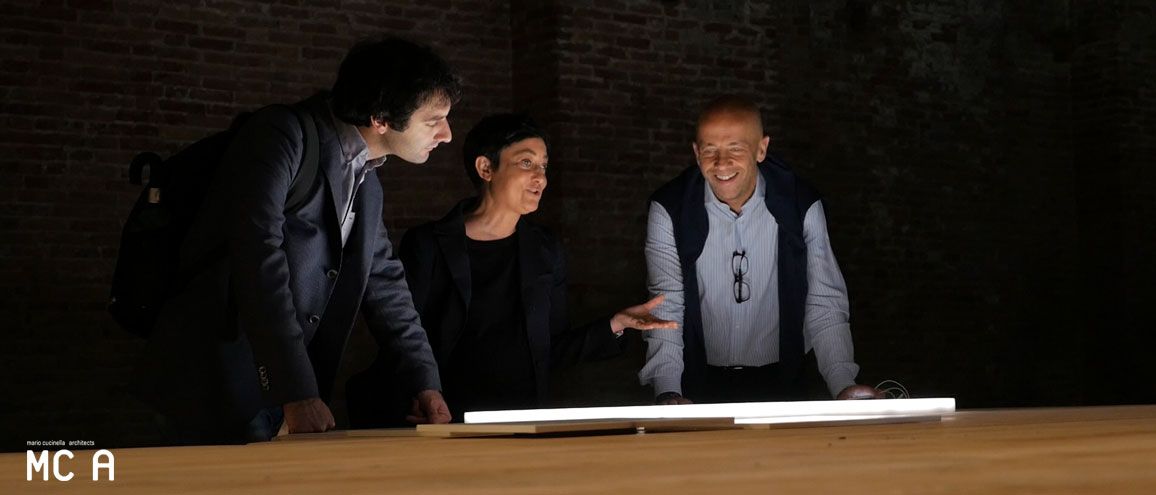Architecture and the art of listening.

Published
28 May 2018
Reading
7 min
By Laura Traldi
Arcipelago Italia, the Italian pavilion at the Venice Architecture Biennale curated by Mario Cucinella, has a great message that transcends architecture. Doing things together is the key to doing things better. Which is already nice and in line with the Freespace theme of the 16th Biennale curated by Grafton. But the really interesting thing is that Arcipelago Italia actually explains how it is possible to move from theory to practise. And it all has to do with listening. As Cucinella explains in this interview, «working in a collective way is necessary to learn how to listen to others. Not to create consensus but to grasp people’s needs».
Architecture as a political act
It was reasonable to expect something similar from Mario Cucinella, who has always been a great promoter of the social and engaged role of architecture. When he was very young, he worked alongside Renzo Piano on city outskirts. He defined the Expo2015 sustainable guidelines (it was the first universal exhibition to have them). Cucinella also founded Building Green Futures, an organization that promotes sustainable development through urban architecture and regeneration. And he started the School of Sustainability SOS, an academy for graduates focused on spreading the culture of sustainability.
Architecture as a concrete social action
But it was also reasonable to expect from him practical action associated with thought. In fact, Mario Cucinella is an architect who rolls up his sleeves, a theorist of “creative empathy”. Which leads him to act, by choice, where architecture can have a real impact. Like in Gaza, where he built a children’s center. Or in Guastalla where he created an eco-sustainable kindergarten at very low cost after the earthquake. And when he delivered 5 projects for public utility buildings for the earthquake zones between Bologna and Ferrara, he did it by working with five young local architectural firms.
A collective work born of listening
So it was to be expected that the Italian pavilion at the 2018 Architecture Biennale would be a collective work. Arcipelago Italia is organized in three parts. The first consists of eight Itineraries: about seventy projects of contemporary architecture among villages, roads, landscapes and parks to explain the widespread quality of Italian territories. The second, called Futures, outlines a possible tomorrow starting from the demographic and sociological data. Such as depopulation, climate change and aging. Phenomena that «it will be possible to slow down only by designing for this purpose», says Cucinella. The third part consists of five Research Projects developed – with a multidisciplinary and participatory approach – by 6 architecture studios together with universities and local professionals. The aim, in this case, is to put architecture back in the center as a response to the relaunch of the territories.
Mario Cucinella, you decided to talk about Italy through what’s in between cities. Why? «Because Italy is made of these middle lands, the ones that that many looks distractedly from the window of a high speed train before arriving in the big cities. Which are not so big. We are obsessed with megalopolis and we talk more and more about metropolitan cities. But in Italy we do not have them. Our country is made up of small towns, productive territories, landscapes ».
Should we consider Archipelago Italy a manifesto against cities? «It should rather be considered as a hypothesis. That considers the fact that Italy exists thanks to an urban model different from that of the megalopolis. The “Italian model” is made up of a network of relationships between small and medium cities and territories, which are the result of cultural and economic interactions. We always look out of our country to figure out where to go instead maybe we have something to say to the world. Because now everyone understood that the cities are not the wonder that everyone believed».
And the idea that density produces culture, creativity, knowledge, work? «It’s not wrong. However, it is also true that when a certain threshold is crossed, the mega conglomerates are not manageable and give rise to terrible inequalities. For this reason, if we talk about quality of life as well as the economy alone, I believe that proximity is preferable to density. In Italy, despite not having really big cities, the centers are no more than 20 minutes apart from each other. And let us not forget that the great inventions of the West were born also thanks to the competition between the city-states».
Yet I assume Arcipelago Italia is not a proposal to go back to the Middle Ages… «Arcipelago Italia is a collective gaze on a world in which what matters is not density but the relationship between the parties. It is not just a question of scale. As a matter of fact we do not only talk about small cities but also about forests».
What does architecture have to do with forests? «A lot. Because inner areas are the lungs of the country: they return oxygen and store CO2. Nature gives wellbeing. But it is abandoned for wrong political choices. I think of infrastructural investments that favor high speed rather than local transport. With the result of cutting out small towns and preventing proximity from working at its best. Or I think of the lack of a logic of exploitation of woodland resources. We have more and more forests, but we import most of the wood. It is an absurdity. These are issues in which architecture should intervene. Because if it is able to interpret the real and chronic shortcomings of the “middle ground”, it can be the first step for a work of real recovery».
What kind of real and chronic shortcomings will the five Research Projects cover? «Delay in the reconstruction of the earthquake zones, for example. Which causes abandonment. The lack of protection of artistic heritage, of a forestry policy. We will talk about hospitals that are not centered on people… Working on these issues has taught a lot to everyone because we have moved in a participatory way. Meeting to discuss issues, brought to the table after a truly impressive listening operation, down on territories. The dialogue took place among heterogeneous people, consultants specialized on cultural heritage, climate change, anthropologists, sociologists … »
When you speak of a listening operation on the territory, what do you mean? «We have worked with Marianella Sclavi, pioneer of Active Listening techniques. It was she who organized participatory workshops in Sicily, Sardinia, in Camerino, Matera, in the mountains … And what has emerged is that people have a very high desire to be there. Listening for real means looking for an actual understanding of issues, without worrying about consensus. When listening is not a façade operation, it gives a huge desire to do to people. It creates an enthusiasm that we have treasured in the projects. And that made us understand that people feel lost because there are no credible and reliable interlocutors for their expectations».
Is listening to people the role of architecture? «What I would like to emerge from Arcipelago Italia is that it is not necessary to have built a tower in Hong Kong to be a good architect. As a matter of fact, what gives sense to architecture, is not scale but a deep understanding of what needs to be done and of how to do it. This is why truly contemporary architecture arises from listening, from dialogue, from active collaborations. And many Italian professionals work according to this approach: quietly, without fanfare, but with constancy. What we are talking about is not new. Rather, it’s a return and a goodbye to the long period of extravagance. Of dream worlds that exist only on paper and of architects’ circles who reward each other. This is the architecture that people need but also, I noticed, also the architecture that young people are interested in».
Is it an architecture that feeds on multi-disciplinarity? «Absolutely. Because being an architect is a complicated job that cannot be done at best in solitude. The collective approach shows that fuelling the profession with a dialogue that includes other sectors is fundamental to reach better solutions. Because complexity must be understood and stratified before being resolved. When a project responds only to the logic of profit, it is like a shopping list. Maybe you bought everything, but you are still far from making a good recipe. Young people understood it. And, maybe even by necessity, they have started to organize themselves into associations, collectives, platforms. We are facing something beautiful and nascent. I wanted the Biennale to give it the space it deserves».








